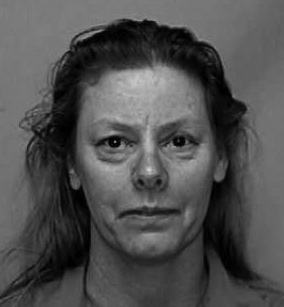Aileen Wuornos
Aileen Wuornos was a tragic case of American history gone wrong, a female serial killer whose troubled life spiraled out of control into multiple murders. The Florida coast experienced a streak of chilling killings through the mid to late eighties. Cold case after cold case piled up when the woman prostitute assaulted victims as she stood by the highway assessing the next murder. The thirty-something blonde woman with the harsh brown eyes and stringy blonde hair would only be arrested after seven men were found dead.

Aileen Carol Wuornos claims to have killed men out of a need to make money, but surely someone as risk taking as she was might have avoided murder if she wished. Wuornos maintained that the killings simply rounded out a robbery modus operandi, and perhaps did not acknowledge herself how damaged psychologically she was in order to do that to them. Wuornos communicated to the court and in her trial testimony in a lucid, almost transparent manner about her serial crimes.
The Wuornos case is a bellwether that proves how the image and stereotype of the serial killer can mask the real criminals in the population at large. Born in Michigan in 1956, Aileen Carol Pittman certainly received more than her share of life’s rocky twists and turns. Aileen Wuornos was far from the typical psycho killer, she was an emotionally distraught woman who viewed murder and robbery as her only pathway to day to day security. It is indicated that even from her first suicide attempt she never received adequate psychological counseling. That said, FBI profiling did help nab Wuornos before she could kill anyone else.
The fact remains that seven men died by the violent hand of Aileen Wuornos, men who might have been able to live after meeting her and/or helping her. They were not given the choice to live. Aileen Wuornos acted alone in her crimes, executing men for money albeit with possible suspicion by her lover, Tyria Moore. The claim of self-defense may have been true emotionally for Wuornos but not criminally, and the court decided in 1992 she was guilty of murder. Wuornos may have stumbled upon a way to bring in cash and exploit her antagonistic violence and hatred of men in positions of power. The murders continued until Wuornos was in a car accident and fled the scene. Medical personnel noted the license of the stolen car and the description of the women in it (Wuornos and Moore).
Wuornos had been isolated and alone most of her life, assuming the life of highway off-ramp prostitute out of a need to make money. Her uneven childhood had resulted in a unstable adolescence spent in bars and random households. Her “mantrap” of corralling her victims via the envelope of a prostitution pose classifies her killings as those of a sexual predator. Using a .22 caliber gun, Wuornos defined her encounters as self-defense, yet not all the men had violent histories. A trail of petty crimes followed in her wake, her repeated use of aliases signaled criminal behavior. Her lesbian relationship with Moore was presumed by many to be less lesbian than opportunistic in nature.
Wuornos’s childhood was a nightmare of rejection, abandonment, and inappropriate sexual relations with first her younger brother and then young neighborhood men. Wuornos grew up under the iron hand of her maternal grandfather, who would kick her out while in her young teens. A harsh, ill-tempered man, he later committed suicide. Wuornos grew up in a climate where the only rhythm she knew was a chaotic mesh of random acts and alcohol abuse. Wuornos took on the life of roadside prostitution after getting kicked out of her home which occurred shortly after the death of her grandmother.
Aileen Wuornos was an emotionally threadbare woman whose life has never been stable, and the murders for many people set her somewhat apart from the accepted idea of a serial killer as a lone male often fixated on sexual deviance. The tough thirty-something killer was an evolution of the runaway girl who never really fit into “normal” family life. The suggestion of physical sexual abuse by her grandfather and perhaps others is credible. Her legacy of violent mood swings from her sex-offender father gives legitimacy to heritability of the criminal state of mind.
Wuornos had killed seven men in first degree murder and robbery, men whose common denominator was mostly that they thought she was in roadside distress or a prostitute available for hire. Aileen was acknowledged by psychiatrists and law enforcement as a somewhat trouble woman, instead of a sociopathic killer bent on enjoying bloody tableaux. Her legal defense campaign hinged around her assertion that her killings were uniformly the result of defense against assaults was treated as false and rejected.
Authorities had been led astray investigating the killings. Bodies and cars found miles apart made no sense to them. Sure, they had a serial killer, but for what reasons the men died and why was a puzzle. How did the victims tie the modus operandi and the killer together, they wondered. Law enforcement collected evidence, but they were limited by Wuornos’ thoroughness in separating the corpse form vehicle, stumping police.
The repeated manner in which Wuornos hid the bodies worked against her at trial. Wuornos had married a much older man briefly in Florida, securing some continuity to her way of living. Yet after eight weeks the man filed for divorce, alleging Wuornos had hit her with his cane. The streak of uncontrollable temper in Wuornos, contrary to her self-interest, evidenced itself in barroom brawls and arrests in Colorado and Florida, and threatening letters and vandalism occurred more than once.
Her parents were married when her mother was fourteen and then divorced and she never met her father. Wuorno’s father was arrested for assault and killed himself in prison. Wuornos herself had given birth as an unwed mother, her grandparents discovering her pregnancy at age fourteen from “activities” with neighborhood boys. Sexual profligacy paired with exigent circumstances might have created in Wuornos the conclusion that sex was her only means to making a living. The killings might have been considered opportunistic if they had not occurred seven times the same way.
Wuornos was without a single positive personality in her life that could have actively enforced a better way of living. Her younger brother died of throat cancer in 1976. Cast out of the family home in her teens, Wuornos aged badly during those years on the road. Further still, Britta Wuornos, her grandmother, may have been in fact murdered by her harsh grandfather. Murder and assault did tend to run in the family. The grandfather’s threats to kill both Aileen and her brother were on record and the children became wards of the court in 1971.
Six counts of first degree murder and seven total victims made Aileen Wuornos the first media-era convicted woman serial killer, a shocking symbol of male-female relations and woman’s liberation. The story of the Wuornos arrest and Death Damsel killings grew to sensational fame and produced two films. Charlize Theron notably portrayed a gritty realization of Wuornos in the film “Monster”. The film depicted the slayings as the work of a woman who allowed her violent rage toward the men in her life free rein as it happened to be expedient to complete the task of robbing them.
Wuornos had a strong character and was noticeably hardheaded and even stubborn to observers. Her life was spent in a largely homeless and migratory manner, and her killings were purposed to capture money and items to lawn for the realization of cash. Her need for transportation and money drove the murders, according to late confessions by Wuornos. The means to live and the cars to move about in required the killing of the men the resources belonged to. Wuornos would later in jail become a born-again Christian and detail her crimes, of which her murders were only a part. Childhood sexual activity and her relationship with women were claimed as violations of God’s law.
Put to death at 46, on October 9, 2002 Wuornos died by lethal injection at Florida State Prison. Her crimes would not be the most numerous with respect to the number of victims but the manner of her killing and the blatant misanthropy evidenced by her testimony shocked many of the public. Wuornos was a female serial killer and that her final letters spoke of remorse and acknowledgment of her transgressions, she became even more of a rarity among convicted serial killers.
Article by Roy Whyte . Visit his Google+ page for more.
For further reading about Aileen Wuornos I recommend Dear Dawn: Aileen Wuornos in Her Own Words .



